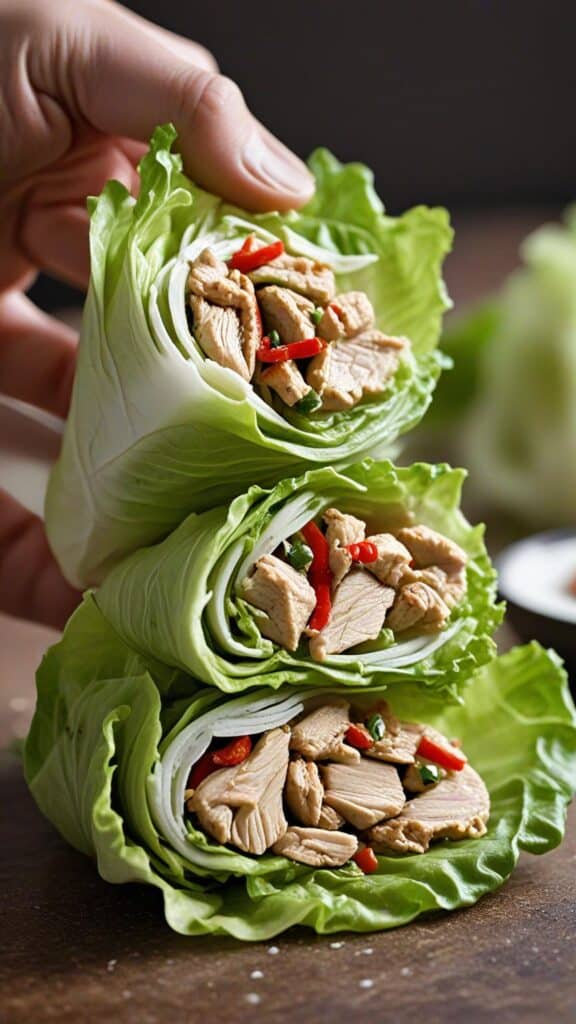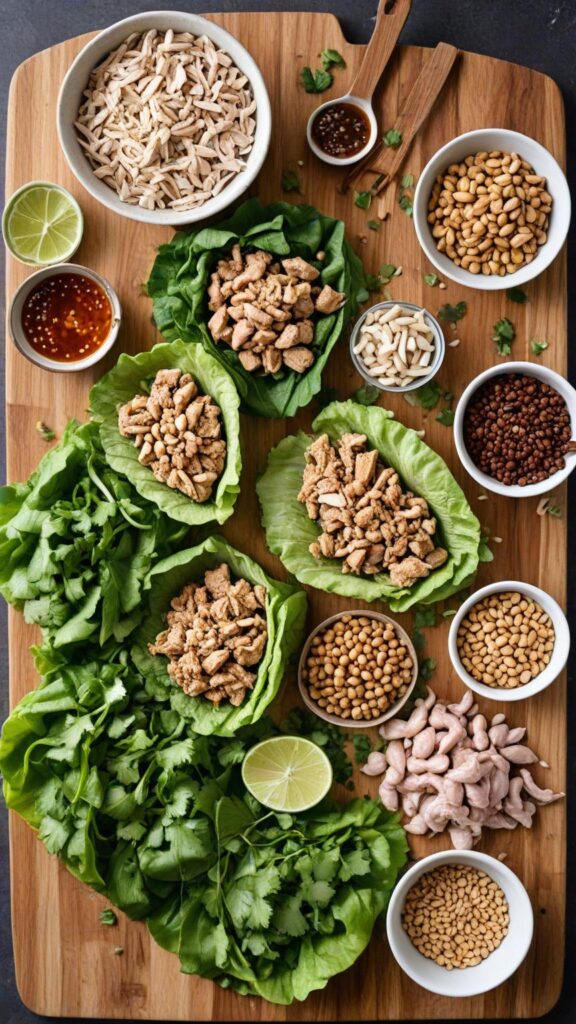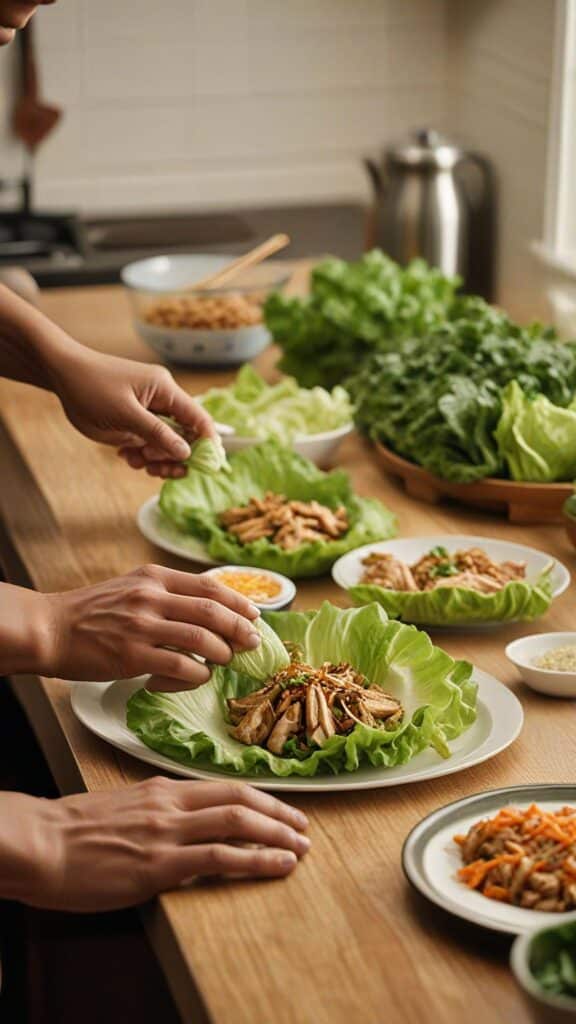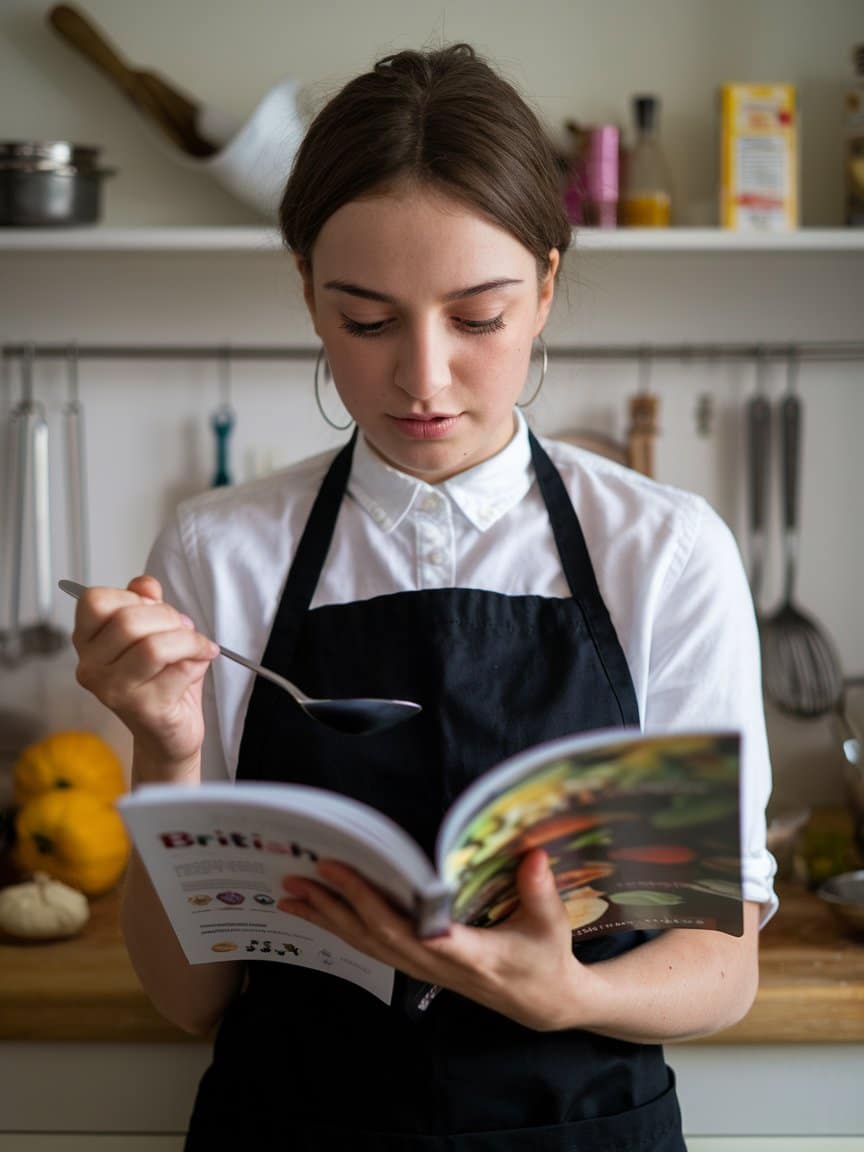The first time I encountered Thai chicken lettuce wraps was during a sweltering summer in Bangkok. I’d wandered into a small family-run establishment tucked away from the tourist trails, where an elderly woman wrapped spiced chicken into crisp lettuce leaves with practiced hands. “This is how we cool down,” she told me with a knowing smile. That meal changed my entire perspective on balanced flavors. What struck me wasn’t just the tantalizing aroma but the symphony of textures and temperatures—hot, spicy chicken against cool, crisp lettuce.
Thai lettuce wraps represent the perfect harmony that Thai cuisine is famous for. They embody the fundamental flavor balance of sweet, salty, sour, and spicy that makes Thai food so addictively satisfying. Unlike their Chinese counterparts, which often lean heavily on hoisin sauce, Thai lettuce wraps dance with lemongrass, fish sauce, and fresh herbs, creating a lighter yet more complex flavor profile. Their portability and customizable nature make them perfect for everything from casual family dinners to sophisticated cocktail parties.
Ingredients & Substitutions
For the Chicken Filling:
- 1 pound ground chicken (preferably thigh meat for more flavor)
- 2 tablespoons vegetable oil
- 3 cloves garlic, minced
- 1 stalk lemongrass, white part only, finely minced
- 1 tablespoon grated ginger
- 1 small shallot, finely diced
- 1-2 Thai bird’s eye chilies, deseeded and minced (adjust according to heat preference)
- 2 tablespoons fish sauce (nam pla)
- 1 tablespoon lime juice
- 2 teaspoons palm sugar or brown sugar
- 1 tablespoon soy sauce
- 2 tablespoons water
- ½ cup chopped fresh herbs (combination of mint, cilantro, and Thai basil)
- 3 green onions, thinly sliced
For Serving:
- 1 head butter lettuce or romaine heart, leaves separated and washed
- ½ cup roasted peanuts, roughly chopped
- ¼ cup fried shallots
- Lime wedges
- Thai sweet chili sauce (optional)
Dont feel constrained by the exact ingredients list. Ground turkey works wonderfully as a lighter alternative to chicken, while tofu crumbles can create a satisfying vegetarian version. If lemongrass proves elusive in your local market, a combination of lemon zest and a touch of ginger can provide a resonable approximation of its citrusy, floral notes. For those with fish allergies, coconut aminos mixed with a touch of mushroom powder creates a surprisingly convincing umami substitute for fish sauce.
The herbs play a crucial role in this dish. While the combination of mint, cilantro, and Thai basil is traditional, don’t panic if you can’t find Thai basil—regular Italian basil will suffice, though it lacks some of the anise notes that make Thai basil special. The butter lettuce specified creates the perfect cup-like shape for holding fillings, but romaine hearts offer more structural integrity if you’re planning to prepare these for a gathering where they might sit for a while.
Step-by-Step Instructions

Preparing the Filling
Heat your wok or large skillet over medium-high heat until a drop of water sizzles and evaporates on contact. This proper preheating is essential—it ensures the chicken sears rather than steams, developing those irresistible caramelized edges. Add the vegetable oil and swirl to coat the surface.
Add garlic, lemongrass, ginger, and shallot to the hot oil, stirring constantly for about 30 seconds until fragrant but not browned. Garlic burns easily and can turn bitter, so keep it moving! When the aromatics release their fragrance, add the ground chicken, breaking it up with a wooden spoon. The key here is to resist the urge to stir constantly—allow the meat to develop some browning by leaving it untouched for 20-30 seconds at a time between stirs.
When the chicken is almost cooked through with just a little pink remaining (about 3-4 minutes), add the chilies, fish sauce, lime juice, sugar, and soy sauce. The sugar might seem like a small amount, but it’s crucial for balancing the saltiness of the fish sauce and creating those caramelized notes that make street food so addictive. Continue cooking for another 2 minutes until the liquid has reduced to a glossy sauce that clings to the meat. If the mixture seems too dry, add the water tablespoon by tablespoon.
Remove from heat and fold in the fresh herbs and green onions, reserving a small amount for garnish. The residual heat will wilt the herbs just enough to release their essential oils without destroying their fresh flavors. Allow the mixture to cool slightly before serving—about 5 minutes is ideal. This resting period allows the flavors to meld and intensify.
Assembly
Lay out your serving platter with the lettuce leaves, arranged in a circular pattern. You want to create a slight overlap, like roof tiles, which both looks attractive and makes it easier for guests to grab individual leaves. Place the warm chicken mixture in the center in a serving bowl that retains heat well—ceramic works brilliantly for this.
Arrange small bowls containing the chopped peanuts, fried shallots, lime wedges, and optional sweet chili sauce around the platter. This creates not only a visually appealing presentation but also allows diners to customize their wraps according to their preferences. The textural contrast between the crisp lettuce, tender chicken, and crunchy toppings is a fundamental part of the eating experience.
To eat, spoon about 2 tablespoons of the chicken mixture onto the center of a lettuce leaf. Top with desired garnishes, fold the sides in, and enjoy imediately. The wraps should be eaten within moments of assembly to appreciate the temperature contrast between the warm filling and cool lettuce.
Cooking Techniques & Science
The success of Thai chicken lettuce wraps hinges on two fundamental cooking principles: proper heat management and ingredient preparation. Traditional Thai cooking employs intense heat for short durations, which develops flavor while maintaining textural integrity. When preparing the chicken mixture, your wok or skillet should be hot enough to create immediate sizzle but not so hot that the aromatics burn.

Mincing the aromatics finely serves a specific purpose beyond even distribution. When garlic, ginger, and lemongrass are cut into tiny pieces, they release more of their essential oils, creating a more potent flavor base. This technique, known as “aromatic foundation” in professional kitchens, establishes the flavor profile before the main ingredient (chicken) is even introduced.
Fish sauce deserves special attention when discussing the science of this dish. It contains glutamates—natural flavor enhancers similar to MSG—that activate umami receptors on our tongues. These compounds dont just add their own flavor; they actually enhance our perception of the other ingredients. This explains why a mere tablespoon transforms the entire dish, making the chicken taste more “chickeny” and heightening all other flavors.
The lettuce itself isn’t merely a delivery vehicle but an active participant in the flavor experience. The high water content of fresh lettuce provides a cooling counterpoint to the warm filling, while also offering textural contrast. Butter lettuce contains slightly bitter compounds that stimulate salivation, actually preparing your palate to better receive the complex flavors of the filling. Some Thai chefs specifically select mature outer leaves for their slightly increased bitterness, creating more dynamic contrast.
Serving & Pairing Suggestions
The communal nature of Thai chicken lettuce wraps makes them ideal for interactive dining experiences. Consider serving them as part of a larger Thai-inspired buffet alongside green papaya salad (som tam) and coconut rice. The cool, crunchy salad and warm, creamy rice provide textural and flavor counterpoints that highlight different elements of the wraps.

For beverage pairings, the high acidity and herb-forward profile of these wraps calls for something equally bright. A crisp Riesling with moderate sweetness beautifully counters the heat of the chilies, while enhancing the aromatic herbs. If you prefer beer, a wheat beer with citrus notes complements the lemongrass and lime components. For non-alcoholic options, Thai iced tea provides stunning contrast, its creamy sweetness taming the heat while its tannins cut through the richness of the chicken.
Presentation can elevate this relatively simple dish to restaurant quality. Consider serving individual portions: place three lettuce cups on each plate, already filled with the chicken mixture but not yet garnished. Provide the garnishes in the center of the table, allowing guests to customize. This approach maintains the interactive element while creating a more elegant initial presentation.
For a modern twist that respects tradition, serve the wraps alongside rice paper wrappers soaked in warm water. This allows guests to create a hybrid dish—they can wrap the lettuce cup in rice paper for a sturdier, more portable option that combines Vietnamese and Thai influences in a respectful fusion.
Conclusion
Thai chicken lettuce wraps represent the perfect harmony of flavor, texture and temperature that makes Thai cuisine so globally beloved. What appears decptively simple—spiced chicken in lettuce cups—actually demonstrates sophisticated culinary principles: balanced flavors, textural contrasts, and temperature variations. By understanding the underlying techniques and flavor science, you can create a dish that transcends its humble ingredients.
The true beauty of these wraps lies in their adaptability—they can be adjusted for heat preference, made lighter or more substantial, and customized at the table to suit individual tastes. Whether served as an impressive appetizer at a dinner party or as the centerpiece of a casual family meal, they bring the vibrant street food culture of Thailand to your table.
Remember that the balance is key—each element from the caramelized chicken to the cool lettuce to the crunchy garnishes plays a vital role in the overall experience. Master this balance, and you’ve mastered not just a recipe, but a fundamental principle of Thai cuisine that you can apply to countless other dishes. Just as that elderly cook in Bangkok showed me years ago, sometimes the most memorable culinary experiences come from the simplest presentations of perfectly balanced flavors.
Frequently Asked Question?
Can I make the chicken filling ahead of time?
Yes, you can prepare the chicken mixture up to 24 hours in advance. Store it in an airtight container in the refrigerator and gently reheat before serving. However, always add the fresh herbs just before serving, as they’ll wilt and darken if added too early. The lettuce should always be prepared just before serving to maintain its crispness.
How do I prevent the lettuce wraps from becoming soggy?
The key is proper draining of the chicken mixture before serving. Cook until most liquid has evaporated, leaving just enough sauce to coat the meat without pooling. Additionally, allow the mixture to cool slightly before serving—the temperature difference between hot filling and cool lettuce creates condensation that can lead to sogginess. For parties, consider serving the components separately for guests to assemble themselves.
What’s the best way to eat these wraps without making a mess?
The traditional approach is to create a small cup with the lettuce leaf, placing the filling in the center rather than all the way to the edges. Fold in the sides slightly before taking a bite from the top. Some Thai establishments serve a larger lettuce leaf underneath as a “drip catcher.” If serving at a formal event, provide small cocktail napkins and consider using romaine hearts, which provide more structural support than butter lettuce.
Can I make these wraps spicy without overwhelming the other flavors?
Absolutely—the key is using the right type of chili. Thai bird’s eye chilies provide heat that builds gradually rather than immediately overwhelming the palate. Remove the seeds and white membrane for less heat while maintaining the flavor. Alternatively, serve thinly sliced fresh chilies as an optional garnish, allowing each person to control their heat level. A touch of honey in the sauce can also help balance increased heat levels.

Veronica is a passionate food enthusiast with over three years of experience in exploring and writing about diverse cuisines. Her expertise lies in reviewing restaurants, sharing creative recipes, and discovering the latest food trends. As the voice behind FoodieRecap.com, Anju brings fresh perspectives and culinary insights to her audience.
